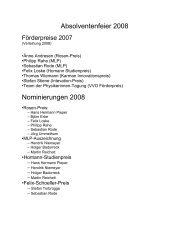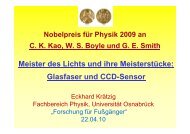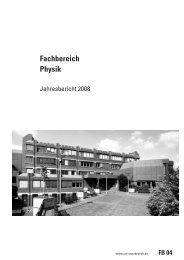Universität Osnabrück, Graduiertenkolleg Mikrostruktur oxidischer
Universität Osnabrück, Graduiertenkolleg Mikrostruktur oxidischer
Universität Osnabrück, Graduiertenkolleg Mikrostruktur oxidischer
Sie wollen auch ein ePaper? Erhöhen Sie die Reichweite Ihrer Titel.
YUMPU macht aus Druck-PDFs automatisch weboptimierte ePaper, die Google liebt.
GRADUIERTENKOLLEG MIKROSTRUKTUR OXIDISCHER KRISTALLE 27<br />
The analysis of the effective charges of atoms surrounding the F center shows that of the two electrons<br />
associated with the removed O atom, only ~ 0.6 e is localized at the vacancy, and about the similar extra charge<br />
is localized on the two nearest Nb atoms. The F center produces a local energy level ~ 0.6 eV above the top of<br />
valence band. Its molecular orbital contains primarily contribution from the atomic orbitals of the two nearest<br />
Nb atoms. The structure optimization based on INDO calculation has also been done for a low-symmetry geometry<br />
corresponding to a room-temperature (ferroelectric) orthorhombic phase of KNbO3. This phase is stable<br />
in a broad temperature range (263 to 498 K) and hence subject to most studies and practical applications. The<br />
structure parameters in pure KNbO3 have been optimized with INDO method in Ref. [3] and are in quite good<br />
agreement with the experimental measurements. In the orthorhombic phase, there are two inequivalent positions<br />
of oxygen and hence the possibility to form two different kinds of F-center, possibly with different optical<br />
properties. The displacements of Nb atoms nearest to Vo were calculated for these both types of defects and<br />
found to be very close to those found for the cubic phase. The relevant relaxation energies (3.6 eV) are also<br />
nearly the same as for the Nb relaxation found in the cubic phase.<br />
Because of different local symmetry at the O site C2v or Cs, in contrast to C4h in the cubic phase, the energetics<br />
of the impurity levels changes. In the cubic phase, the Vo excited state splits into two levels, one of<br />
which remains twofold degenerate. Our ∆SCF calculations predict two relevant bands, the absorption energies<br />
of which are 2.73 and 2.97 eV. In the orthorhombic phase, the degeneracy of the impurity levels is completely<br />
lifted [VIII].<br />
The parametrization for the KTaO3:Li system has been done in Ref. [I] based on the comparison<br />
with the results of earlier FP-LMTO calculations [4]. Our equilibrium [100] off-center displacement of 0.62 Å is<br />
smaller as by Stachiotti and Migoni within the shell model [5]. On the other hand, our value is in good agreement<br />
with a more recent, and apparently more elaborately parametrized, shell model calculation by Exner et al.<br />
0.64 Å, Ref. [6]).<br />
The experimental investigation of the diluted K1-xLixTaO3 system are numerous and include e.g. nuclear<br />
magnetic resonance studies of relaxational dynamics associated with dipole reorientations [7], ultrasound attenuation<br />
measurements [8] and measurements of the low-frequency shear modulus [9]. Due to different technical<br />
limitations, none of these methods allows to attain the ground state of the system in the concentration range x<br />
≤ 7 %.<br />
Up to now, there are reported only few theoretical studies of interacting Li impurities in KTaO3, using<br />
mainly analytical approaches [10] or oversimplified shell model calculations [11], but there are no ab initio<br />
studies reported to our knowledge at this field. In the calculations done by now, we concentrated on two following<br />
subjects: First, we wanted to know how the interaction between Li impurities which substitute two neighboring<br />
K sites affects the energy characteristics and the lattice relaxation associated with each impurity. For this<br />
purpose, we allowed the simultaneous adjustment of the structure coordinates as listed in Ref. [IX,X]. (affecting<br />
both Li impurities and 20 oxygen neighbors). The relaxation of Ta and K atoms was found to be much smaller<br />
than that of O neighbors. The energy gain, that was 57 meV due to the [100] displacement of a single Li impurity<br />
and 151 meV for the oxygen relaxation taken into account, makes correspondingly 176 meV and 407 meV<br />
per two Li impurities. It indicates that a substantial Li-Li interaction of the magnitude E2Li - 2×ELi = 62 meV for<br />
bare Li and 105 meV for Li with oxygen “cloud” indeed occurs and is enhanced by lattice polarization [IX,X].<br />
The second important characteristic is the strength and spatial distribution of the dipole field created by<br />
each Li impurity. In order to study it, we used a “probe” Li impurity at different lattice positions and displaced<br />
in different directions with respect to the “central” one. The “central” impurity was displaced along [100] by<br />
0.62 Å, i.e. the equilibrium displacement for a single off-center Li ion. The “probe” impurity was allowed<br />
to relax along the given direction, and the interaction energy was extracted as a measure of the dipole<br />
field in crystal. The tested positions of the “probe” impurities in the crystal, and the resulting interaction energies<br />
are indicated in Ref. [IX,X]. One can clearly see the anisotropy of the interacting field. It is noteworthy,<br />
however, that the interaction strength decrease with the distance faster than it was found in the shell model calculation<br />
[11].<br />
In KNbO3 we predict the existence of one-site and two site (molecular) polarons with close absorption<br />
energies ~ 1 eV. In the former case the O - ion is displaced towards the K vacancy by 5 % (in units of the lattice<br />
constant ao). Simultaneously, 11 other oxygens surrounding the vacancy are displaced outwards by ≅ 1 % only.<br />
In the two-site (molecular) polaron the two oxygens sharing a hole approach each other by 13 % of the distance<br />
in a perfect lattice. Simultaneously, its center of mass is displaced towards the K vacancy by 4 % of ao. Other<br />
10 nearest O ions are displaced outwards the K vacancy, like in the one-site hole case [XI].<br />
Literatur<br />
1. Vikhnin V.S. 1984 Sov. Phys.-Solid State 29 906<br />
2. Shluger A, Stefanovich E. 1990 Phys. Rev. B 9 9664<br />
3. Eglitis R.I., Postnikov A.V., and Borstel G. 1996 Phys. Rev. B 54 2421







